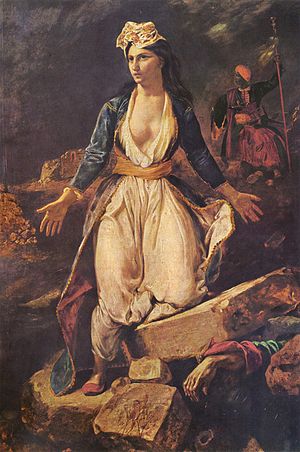Siege of Messolonghi (1825)
| Third Siege of Missolonghi | |||||||
|---|---|---|---|---|---|---|---|
| Part of the Greek War of Independence | |||||||
 Greece Expiring on the Ruins of Missolonghi (1827, Musée des Beaux-Arts, Bordeaux) |
|||||||
|
|||||||
| Belligerents | |||||||
|
|
|
||||||
| Commanders and leaders | |||||||
|
|
|
||||||
| Strength | |||||||
| 5,000 | 20,000 Ottomans 15,000 Ottoman auxiliaries ca. 15,000 Egyptians |
||||||
| Casualties and losses | |||||||
| 8,000+ soldiers and civilians | Unknown | ||||||
The Third Siege of Missolonghi (Greek: Τρίτη Πολιορκία του Μεσσολογίου, often erroneously referred to as the Second Siege) was fought in the Greek War of Independence, between the Ottoman Empire and the Greek rebels, from 15 April 1825 to 10 April 1826. The Ottomans had already tried and failed to capture the city in 1822 and 1823, but returned in 1825 with a stronger force of infantry and a stronger navy supporting the infantry. The Greeks held out for almost a year before they attempted a mass breakout, which however resulted in a disaster, with the larger part of the Greeks slain.
Missolonghi was first besieged by the Ottomans in 1822, then in 1823. In April 1824, Lord Byron died in Missolonghi of an illness, adding to the fame of the city.
In spring 1825, the Ottomans came to besiege the Greeks again. The Ottoman commander Reşid Mehmed Pasha was informed "Either Missolonghi falls or your head" as the Sultan would not tolerate a third failed siege. It was a common practice in the Ottoman empire for those generals who failed the Sultan to pay the price of their failure with their lives. The location of Missiolngi on a long spit of land surrounded by a lagoon full of islands. Three islands, Marmaris, Klisova and Anatokilo controlled the entrance to the lagoon. Much of the ground on the eastern landward side was marshy and on the eastern side was a wide open plain. The town's was surrounded by earthen walls, but their defences had been strengthened as a military engineer from Chios, Michael Kokkinis who had built a series of 17 bastions containing 48 guns and 4 mortars, forming triangular projections so the defender could bring interlocking fire on any attacker. Kokkinis named the bastions after heroes for liberty, naming them after Benjamin Franklin, William of Orange, Tadeusz Kościuszko, Lord Byron, Karl von Normann-Ehrenfels, Markos Botsaris, Skanderbeg, Lord Sheffield, and so on. The defenders were some 3, 000 men, most Greek, but a few were Italian, Swiss and German philhellenes. The Greeks were nominally led by a committee of three, but the dominant personality was a Souliot captain Nótis Bótsaris. The Ottoman forces were 20, 000, of which 8, 000 were professional soldiers, the rest Albanian irregulars while some 4, 000 were Greeks enslaved to work on building the Ottoman entrenchments, which thus left the Greek defenders the bitter feeling of having to kill their own countrymen unwillingly working for the Ottomans. Reshid promptly put his Greek slaves to work building a series of trenches around Missolonghi that gradually brought his men closer to the town, reaching up to 100 yards of Missolonghi. Reshid was at the end of long and tenuous supply lines and simply did not have enough cannonballs to knock down the walls of Missolonghi. Whatever a breach was made, attempts to storm it were beaten off with ferocious counter-attacks while all the citizens of Missolonghi, men and women worked together to fill the breaches in during the night.
...
Wikipedia
